Clip Art for the Passion Death and Glory of Jesus
Whether you lot are religious or not, the ubiquitous symbol of Christ on the cross has infiltrated European culture in many ways, expanding across Christian ritual and iconography.
And in that location is mayhap no other creative subject matter that better reflects the development of art history. The demand for depictions of the suffering Christ immune artists to propel and shape a powerful Biblical narrative that ultimately maintained the widespread practice of Christianity.
Let'south bound back through the centuries, to explore the depictions of the crucifixion plant in UK collections.
Duccio (schoolhouse of)

Duccio di Buoninsegna (c.1255–before 1319) was a Sienese artist who was one of the nigh important painters of the Trecento (fourteenth century).
In the centre of the composition, an artist in the school of Duccio has painted Christ at the moment of his death. His head has fallen to 1 side revealing an expression of pain as blood runs from his hands and head. Flanking him are the two thieves who, according to the Bible, were crucified at the same time. A chorus of six angels surrounds him, bearing expressions of grief. Beneath Christ are the figures of Saint John the Evangelist, the Virgin Mary and Mary Magdalene, who react to the news of his death.
The artist painted this tempera on wood panel sometime between 1315–1330. Information technology is likely they completed the work inside of Duccio's large workshop in Siena, where Duccio trained other notable artists such as Ugolino di Nerio (d.1339/1349) and Simone Martini (1258–1344).
Duccio significantly took inspiration from Byzantine forms, exemplified through his employ of gilded leaf. Notwithstanding, he added a new sense of theatricalism to his religious scenes, oftentimes placing figures inside of architectural settings.
Ugolino di Nerio
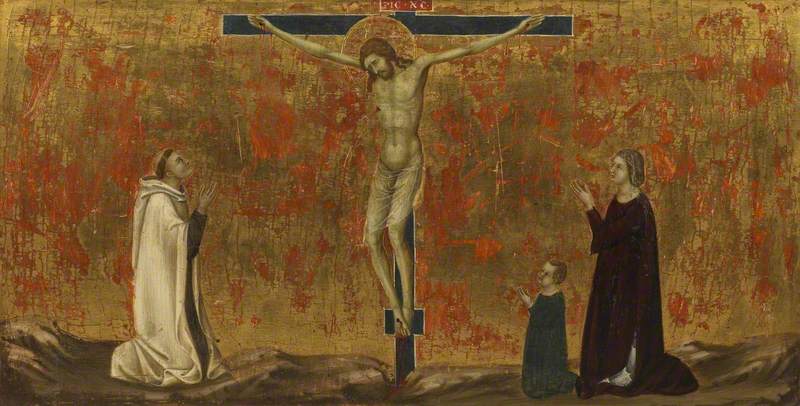
Ugolino di Nerio (d.1339/1349?) painted Crucified Christ with Donors sometime between 1317–1327. Like his teacher Duccio, Di Nerio used an abundance of gold leaf. Here, he paints Christ flanked by 2 contemporary figures – the presumed donors – a Carmelite friar and a adult female with her young son.
Donor paintings ofttimes appear in votive and religious works from the Middle Ages to the Renaissance. They draw the real-life person who commissioned the painting, who is commonly shown kneeling in the foreground in an human action of pious devotion.
Giovanni di Paolo
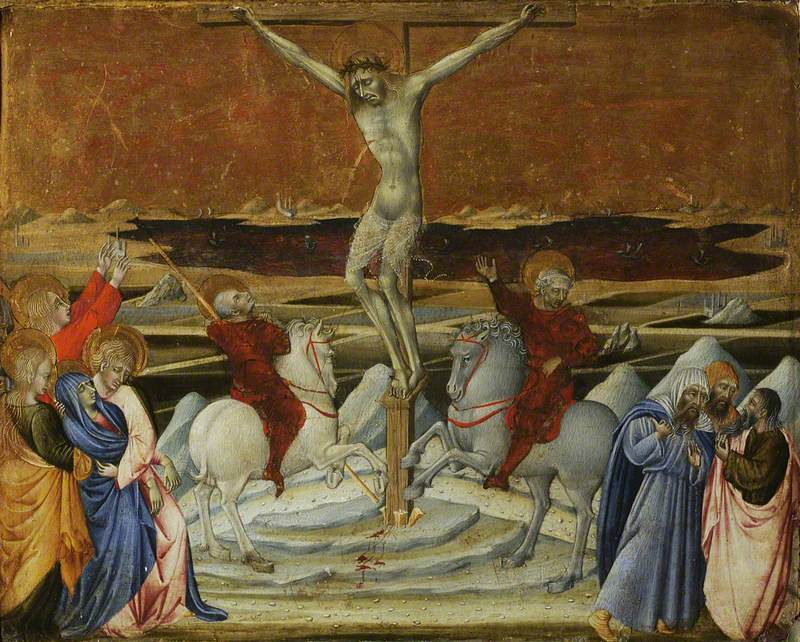
Calvary
Giovanni di Paolo (1403–1482)
Christ Church, University of Oxford
Calvary, or Golgotha, refers to the place where Christ was crucified, just outside the walls of Jerusalem.
Giovanni di Paolo (1403–1482) also belonged to the Sienese school. Little is known about his life though we accept many of his surviving works, many of which are housed in The National Gallery and in Oxford'southward Ashmolean Museum. Di Paolo's works tend to be small-scale, religious panels.
The artist also created an oil on console scene, The Crucifixion(1423–1426).
Ambrogio Bergognone (circle of)
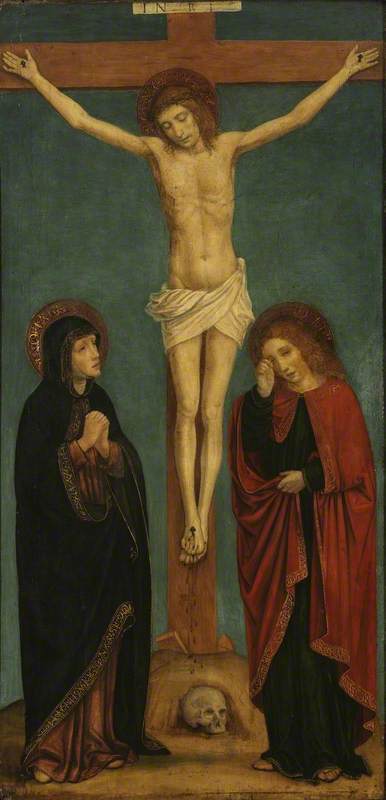
An artist closely associated with the Milanese school was Ambrogio Bergognone (c.1460–1523).
An artist in the circle of Bergognone has painted a skull at the foot of Christ's cross, referring to 'The Identify of the Skull' (another term for Calvary and Golgotha) where Christ was said to have been brought in all iv gospels of the Bible. Although art historians take interpreted the skull every bit a symbol of 'memento mori' (meaning 'remember yous will die'), others take attributed the skull to Adam, who co-ordinate to tradition was also buried close to Calvary. Occasionally, a skeleton is shown at the foot of Christ's cross, for example, seen in Massaccio's famousHoly Trinity (1425).
No longer using gold leaf in the background, this work shows a new kind of perspectival realism.
Jacob Cornelisz. van Oostanen (studio of)
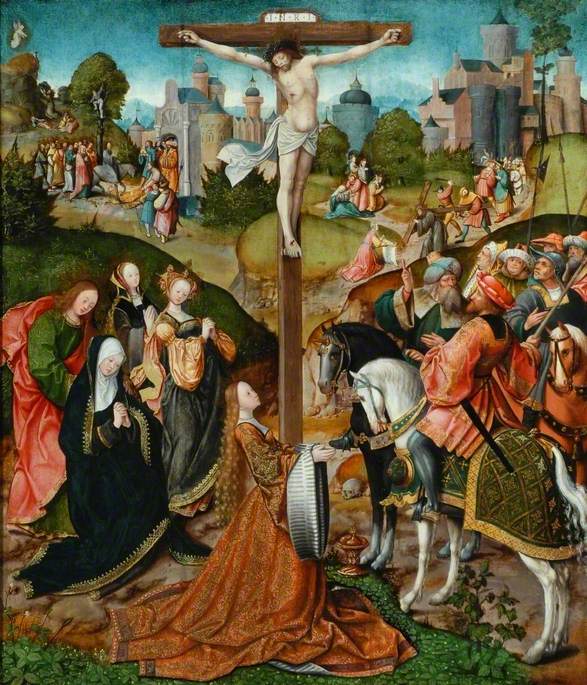
In this Netherlandish depiction of the crucifixion, at that place is equal emphasis on the surrounding landscape and figures flanking the effigy of Christ in the foreground, who are shown wearing contemporary dress. A woman with long red pilus, Mary Magdalene, can be seen praying at Christ's feet.
A Dutch artist based in Amsterdam, Jacob Cornelisz van Oostanen (c.1475–1533) was later influenced by his gimmicky Albrecht Dürer (1471–1528).
Raphael

Raphael (1483–1520) is ane of the about famous painters of the Italian Loftier Renaissance. Born in Urbino though spending most of his life in Rome, he led a nomadic life, roaming around the different regions of Italy. It is likely that he came into contact with the other Italian masters, Michelangelo (1475–1564) and Leonardo da Vinci (1452–1519).
Raphael's The Mond Crucifixion, painted betwixt 1502–1503, includes an intricately detailed landscape in the background, showing his use of perspective, which distinguishes him from artists of the Trecento. Flanking him are two angels communicable his blood in chalices, as well as the figures of the Virgin, Mary Magdalene, Saint Jerome and John the Evangelist. Raphael'southward signature is inscribed into the pes of Christ's cross.
According to The National Gallery, Raphael was nearly likely influenced past beau Umbrian artist Perugino (c.1450–1523). The painting is named after Ludwig Mond, who ancestral the piece of work to the Gallery.
Angelo Nardi (studio of)

This oil on canvass was painted in the mid-seventeenth century in the studio of Agnelo Nardi (1584–1665), an Italian artist working in Spain during the early on-Baroque period. Nardi was mayhap inspired by the Renaissance and Mannerist painter Paolo Veronese (1528–1588).
Once more, the symbol of the skull is shown at the foot of Christ'southward cross. The acronym 'INRI' is shown above Christ's head, which represents the Latin inscription meaning 'Jesus the Nazarene, Rex of the Jews.'
Rembrandt van Rijn
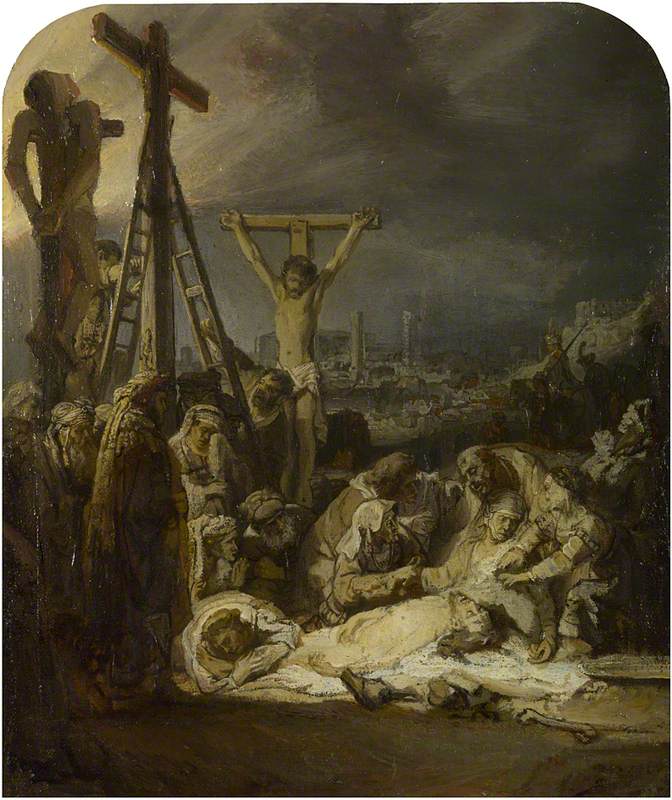
Netherlandish artist Rembrandt van Rijn (1606–1669) painted The Lamentation over the Dead Christ in 1635. Contrasting to typical scenes depicting the moment of crucifixion, in art history, a 'lamentation' scene shows Christ's body being brought downwards from the cross, and the moment his followers mourn over his trunk.
According to The National Gallery, this monochrome oil sketch, known every bit a 'grisaille', was probably made for an carving which was not executed.
Charles Le Brun
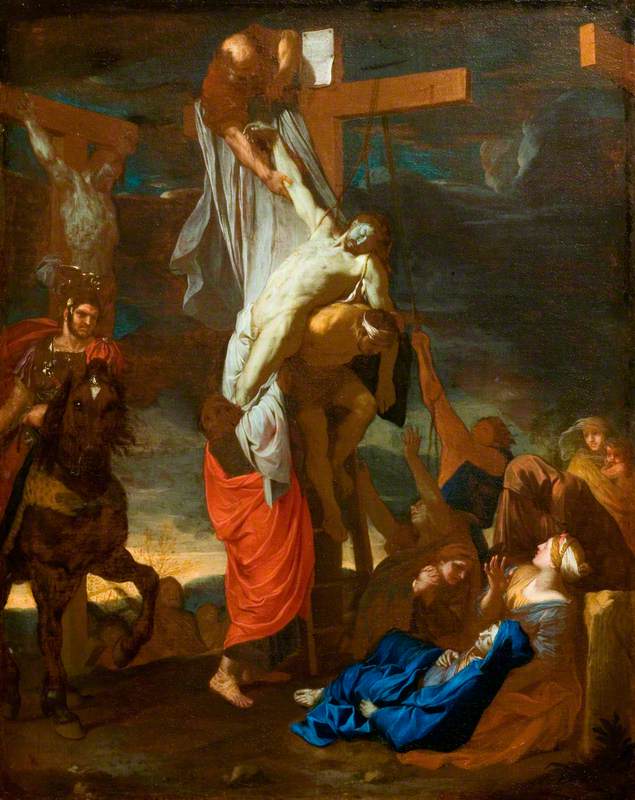
Housed in the Victoria and Albert Museum, this Baroque-fashion painting by prolific French artist Charles Le Brun (1619–1690) shows the moment subsequently Christ'south expiry when he is beingness taken down from the cross.
Charles Le Brun was the court painter of Louis XIV.
Giovanni Domenico Tiepolo
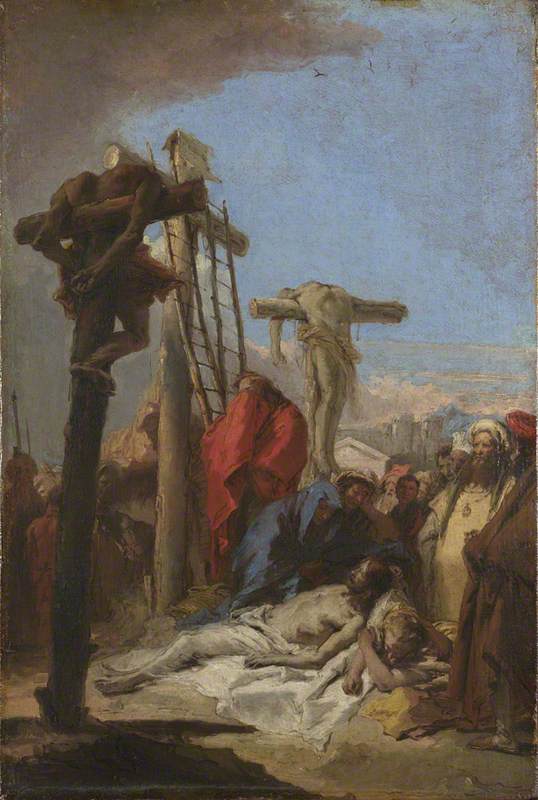
Giovanni Domenico Tiepolo'southward (1727–1804) The Lamentation at the Pes of the Cross is an eighteenth-century delineation of Christ's death, though it bears strong similarities to Rembrandt'southward Lamentation. Tiepolo may well have seen Rembrandt's version, which at the time was in possession of the British Consul, Joseph Smith (1682–1770) who lived in Venice.
In Tiepolo's version, Mary Magdalene is shown with blonde rather than red pilus. In 1760, Tiepolo created a preparatory sketch for the composition with charcoal and ink.
George James Frampton
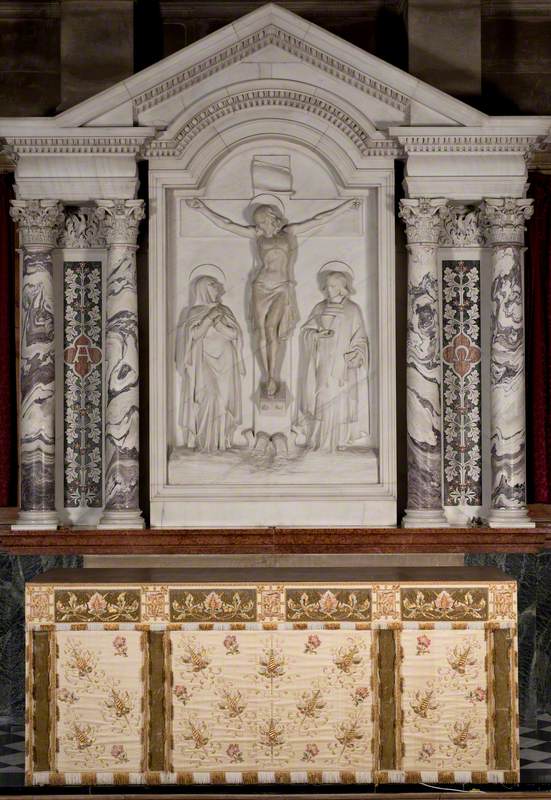
British artist and sculptor George James Frampton (1860–1928) created this stele (stone or wooden slab) of Christ on the cross with his head reclined and optics closed in 1920. Frampton was a leading fellow member of what was afterward termed the New Sculpture move when sculpture shifted towards a higher caste of naturalism.
Michael Rothenstein
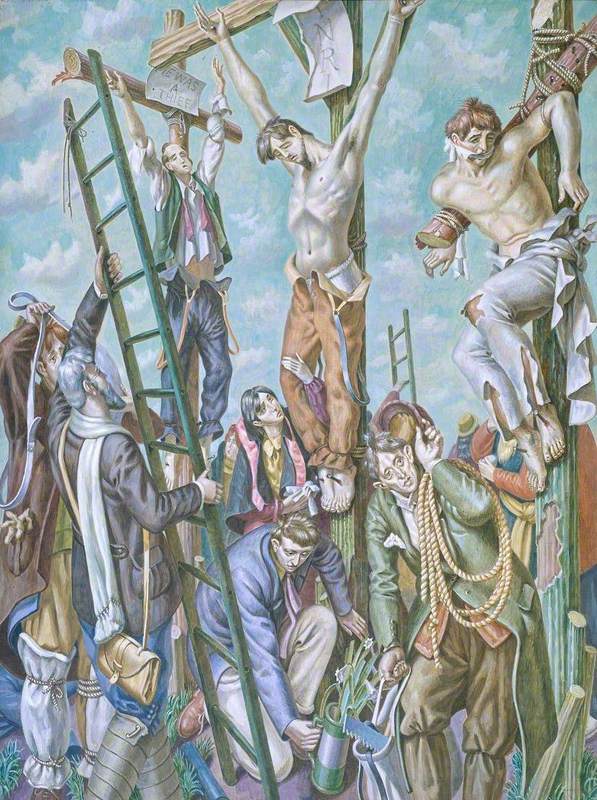
Taking stylistic influence from Stanley Spencer (1891–1959), painter and printmaker Michael Rothenstein (1908–1993)painted several Biblical scenes in modern wearing apparel, which added a new realist dimension to the Passion of Christ. A Jewish artist, Rothenstein painted this Crucifixion scene in 1937, at the height of the rise of Nazism and the beginning of the Spanish Ceremonious State of war (1936–1939), perhaps serving equally a visual and identifiable reminder of man cruelty.
His father was the artist Sir William Rothenstein (1862–1945).
Salvador Dalí
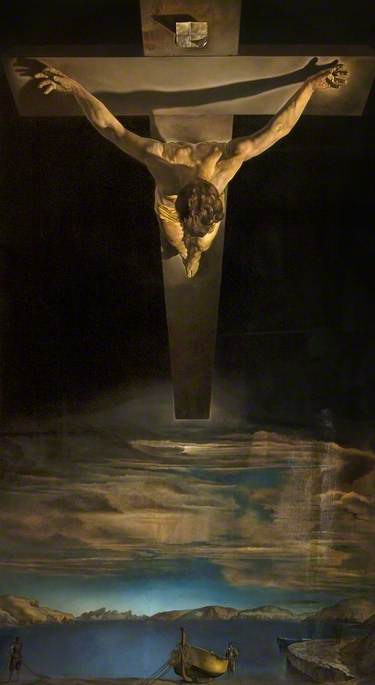
The notorious Spanish Surrealist painter Salvador Dalí (1904–1989) created Christ of St John of the Cross in 1951. In Dalí'southward unusual depiction,Christ floats over a darkened sky, reflected by a shore beneath in which a line-fishing boat is moored. The birds-eye perspective and composition were influenced by a drawing by Spanish mystic John of the Cross (1542–1591) who sketched Christ after claiming he saw the crucifixion in a mystical vision.
Similarly, Dalí claimed he was inspired to paint this unusual depiction of Christ after experiencing a 'cosmic dream'. By the 1940s, Dalí began to render to his religious roots, though previously he had turned away from Catholicism.
It goes without saying that the symbolic image of the crucifixion has kept artists busy for centuries. Today, despite a shift away from religious and devotional paintings, artists take continued to explore the bailiwick – an identifiable and universally understood metaphor for martyrdom and human suffering.
Alternatively, artists have explored the image of Christ on the cross to exist subversive, postmodern or to simply criticise religion, accept for example Andres Serrano's Piss Christ (1987).
From an art historical perspective, portrayals of the crucifixion significantly act every bit historical fossils, allowing u.s.a. to compare artistic shifts and developments across centuries.
Lydia Figes, Content Creator at Fine art UK
Did you know?
- Though disputed, the etymology of the expression 'touch wood' derives from the Christian relics of the cantankerous
- The image of Christ on the cantankerous really emerged before the time of Christ and was used in Heathen iconography
- Ane of the earliest depictions of the dead Christ in Western fine art history is the Gero Cross (965–970). It is displayed in Cologne Cathedral in Frg
More than stories
Artworks
szabadostheabsitters.blogspot.com
Source: https://artuk.org/discover/stories/christ-on-the-cross-depictions-of-the-crucifixion